JEEP RENEGADE 2018 Owner handbook (in English)
Manufacturer: JEEP, Model Year: 2018, Model line: RENEGADE, Model: JEEP RENEGADE 2018Pages: 356, PDF Size: 6.11 MB
Page 211 of 356
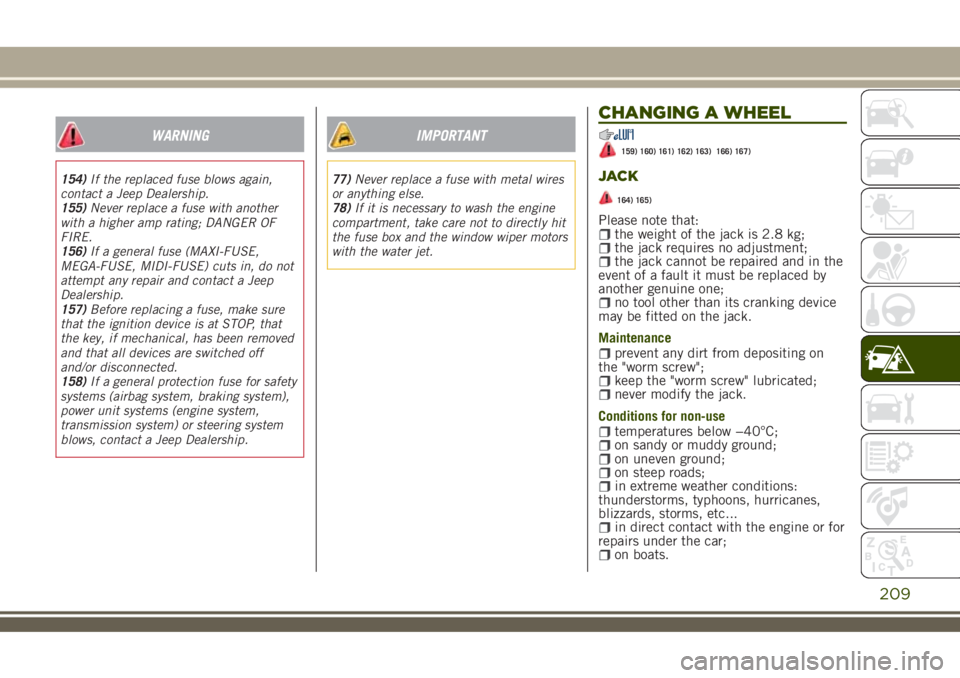
WARNING
154)If the replaced fuse blows again,
contact a Jeep Dealership.
155)Never replace a fuse with another
with a higher amp rating; DANGER OF
FIRE.
156)If a general fuse (MAXI-FUSE,
MEGA-FUSE, MIDI-FUSE) cuts in, do not
attempt any repair and contact a Jeep
Dealership.
157)Before replacing a fuse, make sure
that the ignition device is at STOP, that
the key, if mechanical, has been removed
and that all devices are switched off
and/or disconnected.
158)If a general protection fuse for safety
systems (airbag system, braking system),
power unit systems (engine system,
transmission system) or steering system
blows, contact a Jeep Dealership.
IMPORTANT
77)Never replace a fuse with metal wires
or anything else.
78)If it is necessary to wash the engine
compartment, take care not to directly hit
the fuse box and the window wiper motors
with the water jet.
CHANGING A WHEEL
159) 160) 161) 162) 163) 166) 167)
JACK
164) 165)
Please note that:the weight of the jack is 2.8 kg;the jack requires no adjustment;the jack cannot be repaired and in the
event of a fault it must be replaced by
another genuine one;
no tool other than its cranking device
may be fitted on the jack.
Maintenance
prevent any dirt from depositing on
the "worm screw";
keep the "worm screw" lubricated;never modify the jack.
Conditions for non-use
temperatures below −40°C;on sandy or muddy ground;on uneven ground;on steep roads;in extreme weather conditions:
thunderstorms, typhoons, hurricanes,
blizzards, storms, etc...
in direct contact with the engine or for
repairs under the car;
on boats.
209
Page 212 of 356
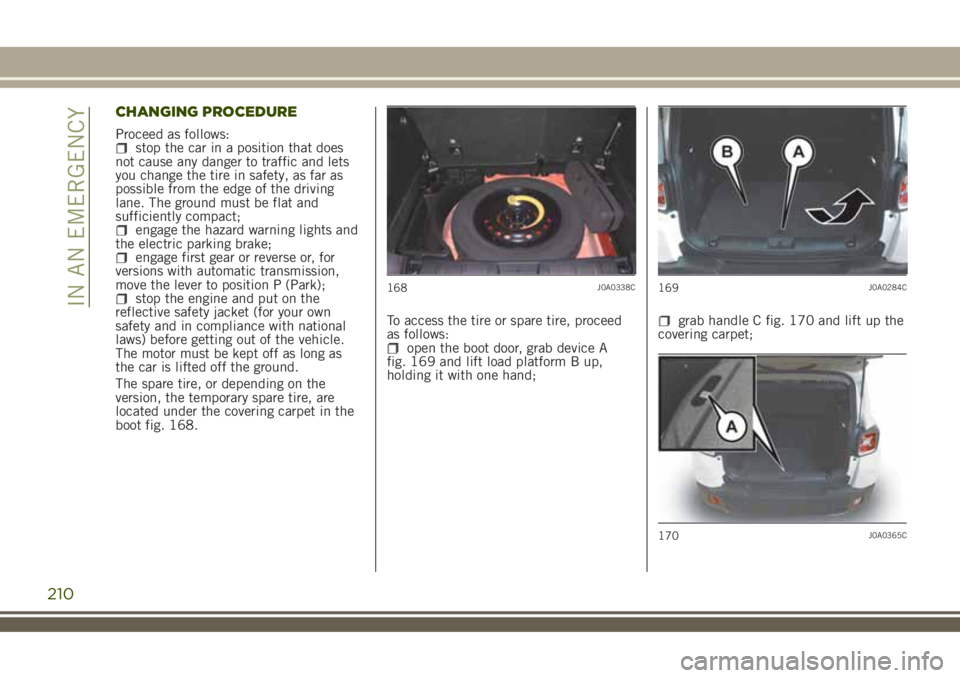
CHANGING PROCEDURE
Proceed as follows:stop the car in a position that does
not cause any danger to traffic and lets
you change the tire in safety, as far as
possible from the edge of the driving
lane. The ground must be flat and
sufficiently compact;
engage the hazard warning lights and
the electric parking brake;
engage first gear or reverse or, for
versions with automatic transmission,
move the lever to position P (Park);
stop the engine and put on the
reflective safety jacket (for your own
safety and in compliance with national
laws) before getting out of the vehicle.
The motor must be kept off as long as
the car is lifted off the ground.
The spare tire, or depending on the
version, the temporary spare tire, are
located under the covering carpet in the
boot fig. 168.To access the tire or spare tire, proceed
as follows:
open the boot door, grab device A
fig. 169 and lift load platform B up,
holding it with one hand;
grab handle C fig. 170 and lift up the
covering carpet;
168J0A0338C169J0A0284C
170J0A0365C
210
IN AN EMERGENCY
Page 213 of 356

remove the spare tire jack's attaching
device;
remove the wheel block wedge;remove the jack and the spanner to
dismount the spare tire bolt. Turn the
jack's screws to loosen the spanner and
separate it from the jack mechanism;
remove the tire from the boot.
Tool kit bag (where there is one)
On the versions with a spare tire, inside
the boot (on the right side) there is a tool
kit latched to the boot's covering carpet
with its own attachments.
Inside the tool kit there are fig. 171:
A: the jack;B: the screwdriver;C: the refuelling adaptor in case of
emergency;
D: the pin to centre to wheel (where
there is one, use it when mounting the
spare tire);
E: a special anti-theft bolt (where
present, use when mounting/dismounting
the tire bolt);
F: a wedge to block the wheel;G: the towing ring;H: the spanner for mounting/locking
the tire bolt and to work the jack;
I: the emergency allen key to activate
the sunroof (where there is one).Important information about the jack
Please note that:
the whole jack weighs 2.8kg;the jack requires no adjustment;
the jack cannot be repaired: if it
breaks, it must be replaced with another
original;
no tool, except the crank wheel, can
be attached to the jack.
Proceed as follows:
in case where you have to place the
car on an inclined roadway, if it is very
steep, or if the ground is unstable, lift
out the blocking wedge A and open it like
a book, as shown in the illustration
fig. 172;
warn anyone present that the car is
going to be lifted up: they need to leave
the immediate vicinity and even more
important, warn them not to touch the
car until it has been brought back down.
171J0A0226C172J0A0157C
211
Page 214 of 356
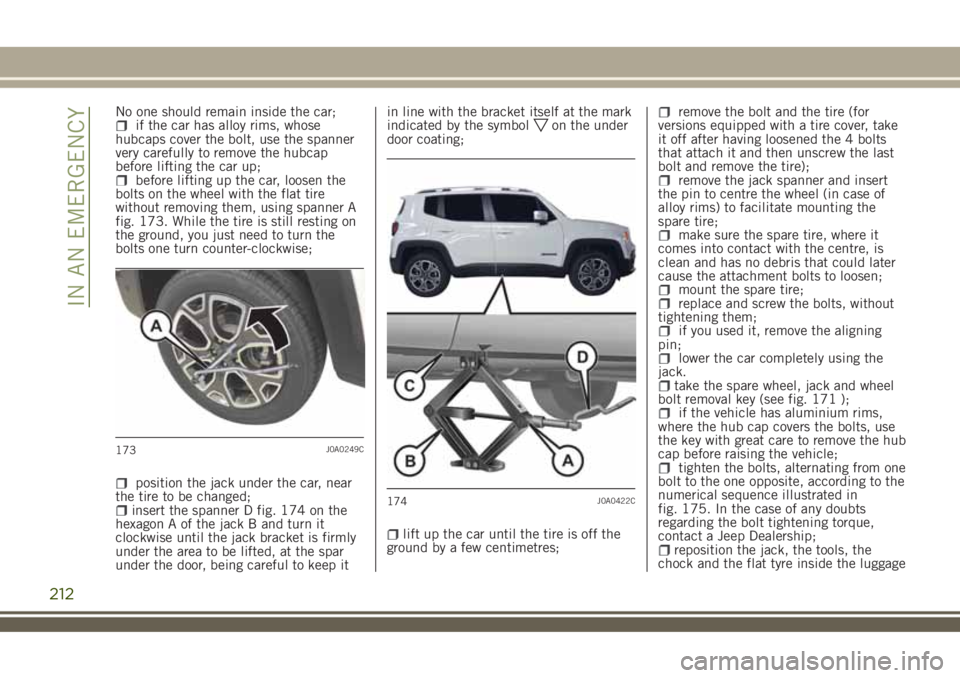
No one should remain inside the car;if the car has alloy rims, whose
hubcaps cover the bolt, use the spanner
very carefully to remove the hubcap
before lifting the car up;
before lifting up the car, loosen the
bolts on the wheel with the flat tire
without removing them, using spanner A
fig. 173. While the tire is still resting on
the ground, you just need to turn the
bolts one turn counter-clockwise;
position the jack under the car, near
the tire to be changed;
insert the spanner D fig. 174 on the
hexagon A of the jack B and turn it
clockwise until the jack bracket is firmly
under the area to be lifted, at the spar
under the door, being careful to keep itin line with the bracket itself at the mark
indicated by the symbol
on the under
door coating;
lift up the car until the tire is off the
ground by a few centimetres;
remove the bolt and the tire (for
versions equipped with a tire cover, take
it off after having loosened the 4 bolts
that attach it and then unscrew the last
bolt and remove the tire);
remove the jack spanner and insert
the pin to centre the wheel (in case of
alloy rims) to facilitate mounting the
spare tire;
make sure the spare tire, where it
comes into contact with the centre, is
clean and has no debris that could later
cause the attachment bolts to loosen;
mount the spare tire;replace and screw the bolts, without
tightening them;
if you used it, remove the aligning
pin;
lower the car completely using the
jack.
take the spare wheel, jack and wheel
bolt removal key (see fig. 171 );
if the vehicle has aluminium rims,
where the hub cap covers the bolts, use
the key with great care to remove the hub
cap before raising the vehicle;
tighten the bolts, alternating from one
bolt to the one opposite, according to the
numerical sequence illustrated in
fig. 175. In the case of any doubts
regarding the bolt tightening torque,
contact a Jeep Dealership;
reposition the jack, the tools, the
chock and the flat tyre inside the luggage
173J0A0249C
174J0A0422C
212
IN AN EMERGENCY
Page 215 of 356
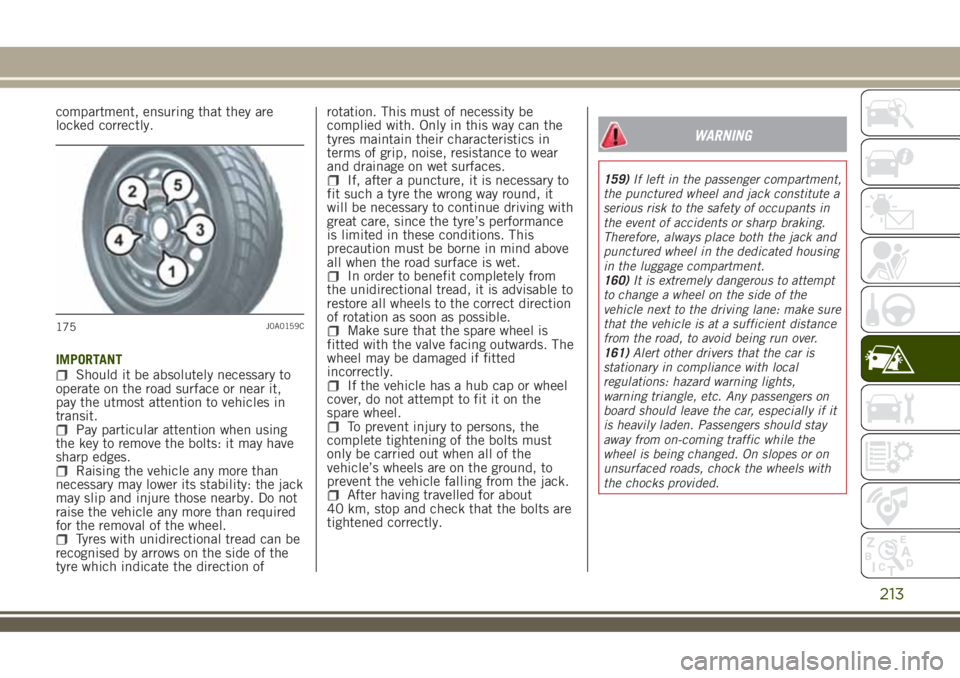
compartment, ensuring that they are
locked correctly.
IMPORTANT
Should it be absolutely necessary to
operate on the road surface or near it,
pay the utmost attention to vehicles in
transit.
Pay particular attention when using
the key to remove the bolts: it may have
sharp edges.
Raising the vehicle any more than
necessary may lower its stability: the jack
may slip and injure those nearby. Do not
raise the vehicle any more than required
for the removal of the wheel.
Tyres with unidirectional tread can be
recognised by arrows on the side of the
tyre which indicate the direction ofrotation. This must of necessity be
complied with. Only in this way can the
tyres maintain their characteristics in
terms of grip, noise, resistance to wear
and drainage on wet surfaces.
If, after a puncture, it is necessary to
fit such a tyre the wrong way round, it
will be necessary to continue driving with
great care, since the tyre’s performance
is limited in these conditions. This
precaution must be borne in mind above
all when the road surface is wet.
In order to benefit completely from
the unidirectional tread, it is advisable to
restore all wheels to the correct direction
of rotation as soon as possible.
Make sure that the spare wheel is
fitted with the valve facing outwards. The
wheel may be damaged if fitted
incorrectly.
If the vehicle has a hub cap or wheel
cover, do not attempt to fit it on the
spare wheel.
To prevent injury to persons, the
complete tightening of the bolts must
only be carried out when all of the
vehicle’s wheels are on the ground, to
prevent the vehicle falling from the jack.
After having travelled for about
40 km, stop and check that the bolts are
tightened correctly.
WARNING
159)If left in the passenger compartment,
the punctured wheel and jack constitute a
serious risk to the safety of occupants in
the event of accidents or sharp braking.
Therefore, always place both the jack and
punctured wheel in the dedicated housing
in the luggage compartment.
160)It is extremely dangerous to attempt
to change a wheel on the side of the
vehicle next to the driving lane: make sure
that the vehicle is at a sufficient distance
from the road, to avoid being run over.
161)Alert other drivers that the car is
stationary in compliance with local
regulations: hazard warning lights,
warning triangle, etc. Any passengers on
board should leave the car, especially if it
is heavily laden. Passengers should stay
away from on-coming traffic while the
wheel is being changed. On slopes or on
unsurfaced roads, chock the wheels with
the chocks provided.
175J0A0159C
213
Page 216 of 356
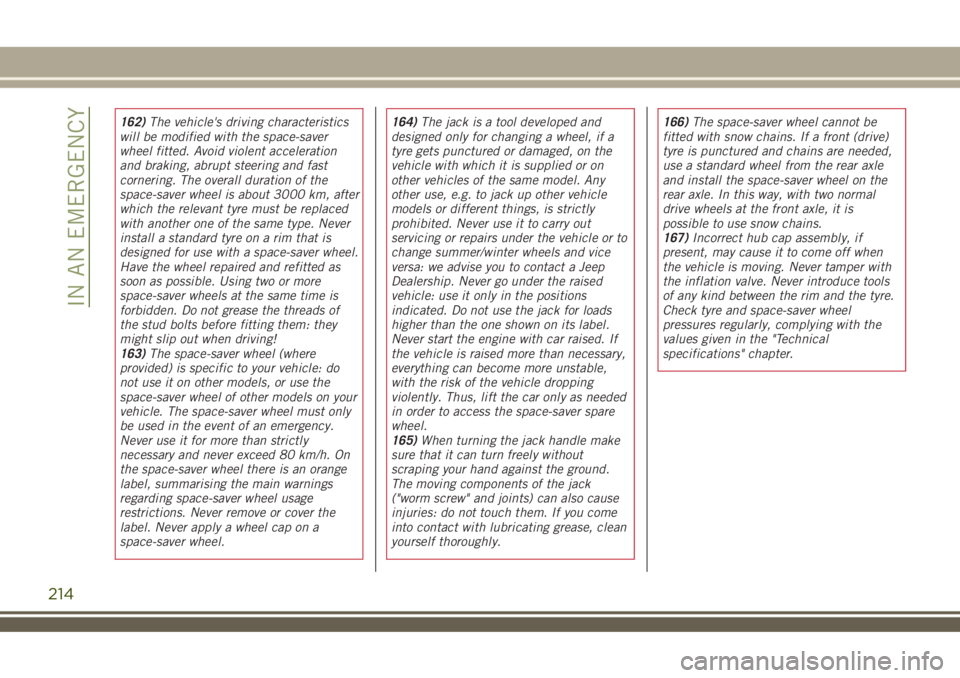
214
IN AN EMERGENCY
162)The vehicle's driving characteristics
will be modified with the space-saver
wheel fitted. Avoid violent acceleration
and braking, abrupt steering and fast
cornering. The overall duration of the
space-saver wheel is about 3000 km, after
which the relevant tyre must be replaced
with another one of the same type. Never
install a standard tyre on a rim that is
designed for use with a space-saver wheel.
Have the wheel repaired and refitted as
soon as possible. Using two or more
space-saver wheels at the same time is
forbidden. Do not grease the threads of
the stud bolts before fitting them: they
might slip out when driving!
163)The space-saver wheel (where
provided) is specific to your vehicle: do
not use it on other models, or use the
space-saver wheel of other models on your
vehicle. The space-saver wheel must only
be used in the event of an emergency.
Never use it for more than strictly
necessary and never exceed 80 km/h. On
the space-saver wheel there is an orange
label, summarising the main warnings
regarding space-saver wheel usage
restrictions. Never remove or cover the
label. Never apply a wheel cap on a
space-saver wheel.164)The jack is a tool developed and
designed only for changing a wheel, if a
tyre gets punctured or damaged, on the
vehicle with which it is supplied or on
other vehicles of the same model. Any
other use, e.g. to jack up other vehicle
models or different things, is strictly
prohibited. Never use it to carry out
servicing or repairs under the vehicle or to
change summer/winter wheels and vice
versa: we advise you to contact a Jeep
Dealership. Never go under the raised
vehicle: use it only in the positions
indicated. Do not use the jack for loads
higher than the one shown on its label.
Never start the engine with car raised. If
the vehicle is raised more than necessary,
everything can become more unstable,
with the risk of the vehicle dropping
violently. Thus, lift the car only as needed
in order to access the space-saver spare
wheel.
165)When turning the jack handle make
sure that it can turn freely without
scraping your hand against the ground.
The moving components of the jack
("worm screw" and joints) can also cause
injuries: do not touch them. If you come
into contact with lubricating grease, clean
yourself thoroughly.166)The space-saver wheel cannot be
fitted with snow chains. If a front (drive)
tyre is punctured and chains are needed,
use a standard wheel from the rear axle
and install the space-saver wheel on the
rear axle. In this way, with two normal
drive wheels at the front axle, it is
possible to use snow chains.
167)Incorrect hub cap assembly, if
present, may cause it to come off when
the vehicle is moving. Never tamper with
the inflation valve. Never introduce tools
of any kind between the rim and the tyre.
Check tyre and space-saver wheel
pressures regularly, complying with the
values given in the "Technical
specifications" chapter.
Page 217 of 356

TIREKIT
(where provided)
DESCRIPTION
168) 169)
79)
3)
The TireKit is located in the luggage
compartment inside its own box. The
container is also equipped with a
screwdriver, the tow ring and the
refuelling adaptor.
LPG versions
The car has a “TireKit” quick tyre repair
kit, not a space-saver spare wheel,
located in the boot inside a specific rigid
preformed housing fig. 176.The TireKit fig. 177 comprises:
one cartridge A containing sealant and
fitted with: transparent tube for injecting
the sealant and sticker C with the
wording MAX 80 km/h / 50 mph to be
placed in a clearly visible position (e.g.
on the dashboard) after repairing the
tyre;
one compressor B;one leaflet containing instructions for
using the kit;
a pair of gloves located in the hose
compartment of the cartridge D.
REPAIR PROCEDURE
Proceed as follows:stop the car in a position that is not
dangerous for oncoming traffic where you
can change the wheel safely. The car
must be stopped in a lay-by, car-park or
parking or service area, and the ground
must be as level as possible and
sufficiently compact;
switch off the engine, apply the
electrical parking brake and engage the
1st gear or reverse gear. Make sure that
any passengers get out of the car and go
to a safe place where they will not
obstruct traffic or be exposed to the risk
of injury. Wear the reflective safety jacket
(compulsory by law) before getting out of
the car;
176J0A0947C177J0A0955C
215
Page 218 of 356
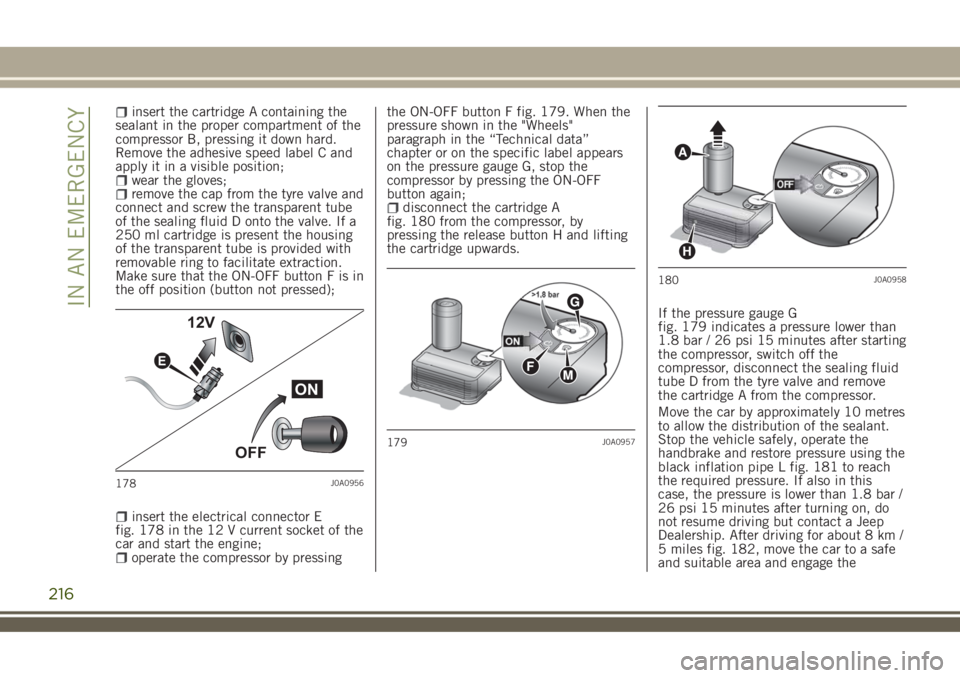
insert the cartridge A containing the
sealant in the proper compartment of the
compressor B, pressing it down hard.
Remove the adhesive speed label C and
apply it in a visible position;
wear the gloves;remove the cap from the tyre valve and
connect and screw the transparent tube
of the sealing fluid D onto the valve. If a
250 ml cartridge is present the housing
of the transparent tube is provided with
removable ring to facilitate extraction.
Make sure that the ON-OFF button F is in
the off position (button not pressed);
insert the electrical connector E
fig. 178 in the 12 V current socket of the
car and start the engine;
operate the compressor by pressingthe ON-OFF button F fig. 179. When the
pressure shown in the "Wheels"
paragraph in the “Technical data”
chapter or on the specific label appears
on the pressure gauge G, stop the
compressor by pressing the ON-OFF
button again;
disconnect the cartridge A
fig. 180 from the compressor, by
pressing the release button H and lifting
the cartridge upwards.
If the pressure gauge G
fig. 179 indicates a pressure lower than
1.8 bar / 26 psi 15 minutes after starting
the compressor, switch off the
compressor, disconnect the sealing fluid
tube D from the tyre valve and remove
the cartridge A from the compressor.
Move the car by approximately 10 metres
to allow the distribution of the sealant.
Stop the vehicle safely, operate the
handbrake and restore pressure using the
black inflation pipe L fig. 181 to reach
the required pressure. If also in this
case, the pressure is lower than 1.8 bar /
26 psi 15 minutes after turning on, do
not resume driving but contact a Jeep
Dealership. After driving for about 8 km /
5 miles fig. 182, move the car to a safe
and suitable area and engage the
ON
OFF 12V
E
178J0A0956
179J0A0957
A
H
180J0A0958
216
IN AN EMERGENCY
Page 219 of 356
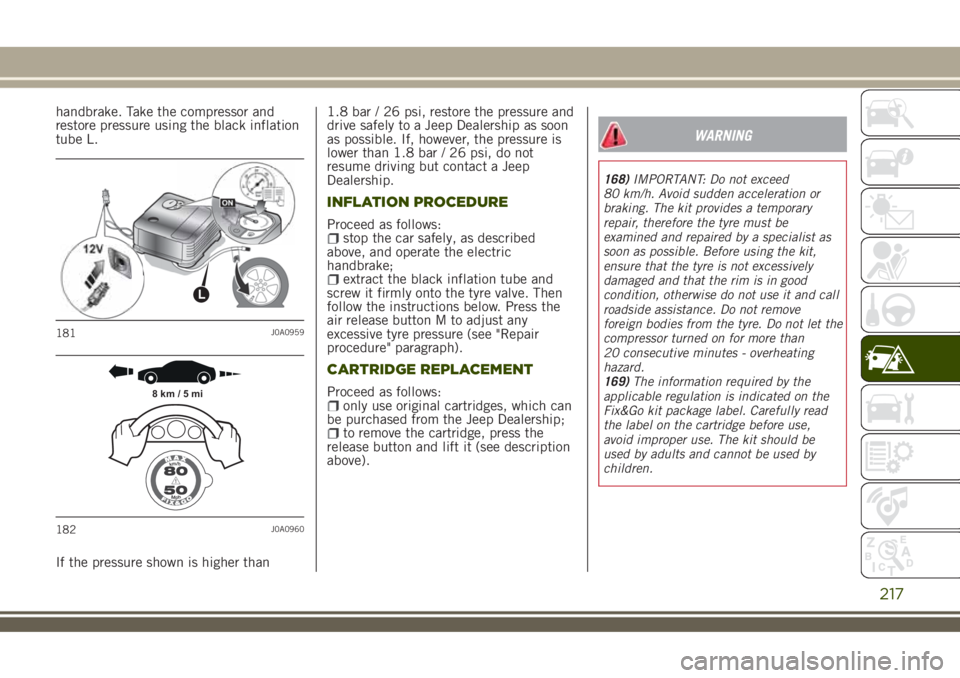
handbrake. Take the compressor and
restore pressure using the black inflation
tube L.
If the pressure shown is higher than1.8 bar / 26 psi, restore the pressure and
drive safely to a Jeep Dealership as soon
as possible. If, however, the pressure is
lower than 1.8 bar / 26 psi, do not
resume driving but contact a Jeep
Dealership.
INFLATION PROCEDURE
Proceed as follows:stop the car safely, as described
above, and operate the electric
handbrake;
extract the black inflation tube and
screw it firmly onto the tyre valve. Then
follow the instructions below. Press the
air release button M to adjust any
excessive tyre pressure (see "Repair
procedure" paragraph).
CARTRIDGE REPLACEMENT
Proceed as follows:only use original cartridges, which can
be purchased from the Jeep Dealership;
to remove the cartridge, press the
release button and lift it (see description
above).
WARNING
168)IMPORTANT: Do not exceed
80 km/h. Avoid sudden acceleration or
braking. The kit provides a temporary
repair, therefore the tyre must be
examined and repaired by a specialist as
soon as possible. Before using the kit,
ensure that the tyre is not excessively
damaged and that the rim is in good
condition, otherwise do not use it and call
roadside assistance. Do not remove
foreign bodies from the tyre. Do not let the
compressor turned on for more than
20 consecutive minutes - overheating
hazard.
169)The information required by the
applicable regulation is indicated on the
Fix&Go kit package label. Carefully read
the label on the cartridge before use,
avoid improper use. The kit should be
used by adults and cannot be used by
children.
L
181J0A0959
8 km / 5 mi
182J0A0960
217
Page 220 of 356
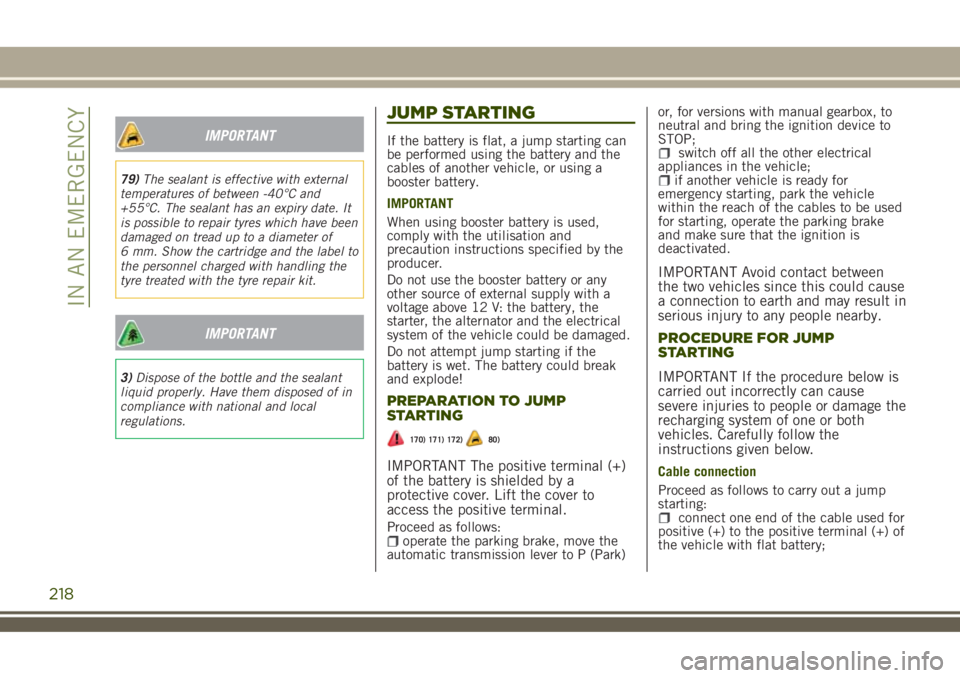
IMPORTANT
79)The sealant is effective with external
temperatures of between -40°C and
+55°C. The sealant has an expiry date. It
is possible to repair tyres which have been
damaged on tread up to a diameter of
6 mm. Show the cartridge and the label to
the personnel charged with handling the
tyre treated with the tyre repair kit.
IMPORTANT
3)Dispose of the bottle and the sealant
liquid properly. Have them disposed of in
compliance with national and local
regulations.
JUMP STARTING
If the battery is flat, a jump starting can
be performed using the battery and the
cables of another vehicle, or using a
booster battery.
IMPORTANT
When using booster battery is used,
comply with the utilisation and
precaution instructions specified by the
producer.
Do not use the booster battery or any
other source of external supply with a
voltage above 12 V: the battery, the
starter, the alternator and the electrical
system of the vehicle could be damaged.
Do not attempt jump starting if the
battery is wet. The battery could break
and explode!
PREPARATION TO JUMP
STARTING
170) 171) 172)80)
IMPORTANT The positive terminal (+)
of the battery is shielded by a
protective cover. Lift the cover to
access the positive terminal.
Proceed as follows:operate the parking brake, move the
automatic transmission lever to P (Park)or, for versions with manual gearbox, to
neutral and bring the ignition device to
STOP;
switch off all the other electrical
appliances in the vehicle;
if another vehicle is ready for
emergency starting, park the vehicle
within the reach of the cables to be used
for starting, operate the parking brake
and make sure that the ignition is
deactivated.
IMPORTANT Avoid contact between
the two vehicles since this could cause
a connection to earth and may result in
serious injury to any people nearby.
PROCEDURE FOR JUMP
STARTING
IMPORTANT If the procedure below is
carried out incorrectly can cause
severe injuries to people or damage the
recharging system of one or both
vehicles. Carefully follow the
instructions given below.
Cable connection
Proceed as follows to carry out a jump
starting:
connect one end of the cable used for
positive (+) to the positive terminal (+) of
the vehicle with flat battery;
218
IN AN EMERGENCY